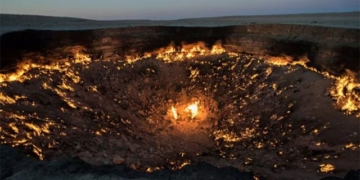The laser machine located at the Thales research center can reach a peak power of 10 petawatts in an extremely short time.
In the control room of a research center in Romania, engineer Antonia Toma activates the world’s strongest laser beam, promising to revolutionize fields from healthcare to space exploration. The laser machine, situated near the capital Bucharest, Romania, is operated by the French company Thales, utilizing a Nobel Prize-winning invention, AFP reported on March 31. Researchers Gerard Mourou (France) and Donna Strickland (Canada) won the Nobel Prize in Physics in 2018 for harnessing the power of lasers to create high-precision devices in eye surgery and industrial applications.

The research center housing the world’s most powerful laser. (Photo: AFP).
At the center, in front of a wall filled with screens displaying the light beam, Toma checks a series of indicators before starting the countdown. On the other side of the glass, long rows of red and black boxes contain two laser systems. The scale of operations at the research center is enormous. The system can achieve a peak power of 10 petawatts (one petawatt equals 10 to the power of 15 watts) in an ultra-short time frame of femtoseconds (one femtosecond equals one quadrillionth of a second). Engineers had to carefully install 450 tons of equipment to achieve this exceptional performance, according to Franck Leibreich, the director of laser solutions at Thales.
Mourou acknowledged that he is deeply moved after an extraordinary journey from the United States, where he worked for 30 years, to bring this project to life in Europe. The project originated in the 2000s from the larger ELI infrastructure project funded by the European Union.
The high-tech building housing the research center cost $350 million to construct, primarily funded by the European Union. Thales stated that this is the largest investment in scientific research in Romania. Meanwhile, countries including France, China, and the United States are pushing forward with their own projects to produce even more powerful laser machines.
The scientific community continuously seeks to create even stronger lasers. However, in the mid-1980s, they encountered a barrier that prevented them from increasing power without compromising the amplification of the light beam. That’s when Mourou and Strickland, who was his student at the time, invented a technique known as Chirped-Pulse Amplification (CPA), which allows for safe power increase and amplification.
This technique works by stretching the ultra-short laser pulse, amplifying it, and then compressing it again, producing the shortest and most powerful laser pulse in the world. CPA has been applied in eye surgery but could pave the way for scientists to continue pushing the boundaries of laser technology. “We will use this ultra-powerful pulse to produce many compact particle accelerators at even lower costs” to destroy cancer cells, Mourou said.
Other potential applications include processing radioactive waste by reducing the operational time of radioactivity or clearing accumulated debris in space. For Mourou, the last century belonged to electrons, while the 21st century is the era of lasers.




















































